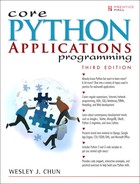Contents
Part I General Application Topics
1.2 Special Symbols and Characters
2.2 What Is Client/Server Architecture?
2.3 Sockets: Communication Endpoints
2.4 Network Programming in Python
2.6 *Introduction to the Twisted Framework
Chapter 3 Internet Client Programming
3.1 What Are Internet Clients?
Chapter 4 Multithreaded Programming
4.6 Comparing Single vs. Multithreaded Execution
4.7 Multithreading in Practice
4.8 Producer-Consumer Problem and the Queue/queue Module
4.9 Alternative Considerations to Threads
5.2 Tkinter and Python Programming
5.4 A Brief Tour of Other GUIs
5.5 Related Modules and Other GUIs
Chapter 6 Database Programming
Chapter 7 *Programming Microsoft Office
7.2 COM Client Programming with Python
8.2 Extending Python by Writing Extensions
Chapter 9 Web Clients and Servers
Chapter 10 Web Programming: CGI and WSGI
10.2 Helping Web Servers Process Client Data
10.3 Building CGI Applications
10.7 Real-World Web Development
Chapter 11 Web Frameworks: Django
11.5 Your “Hello World” Application (A Blog)
11.6 Creating a Model to Add Database Service
11.7 The Python Application Shell
11.8 The Django Administration App
11.9 Creating the Blog’s User Interface
11.14 *Look-and-Feel Improvements
11.16 *An Intermediate Django App: The TweetApprover
Chapter 12 Cloud Computing: Google App Engine
12.3 The Sandbox and the App Engine SDK
12.4 Choosing an App Engine Framework
12.7 Morphing “Hello World” into a Simple Blog
12.12 Lightning Round (with Python Code)
12.13 Sending Instant Messages by Using XMPP
12.15 Task Queues (Unscheduled Tasks)
12.18 Lightning Round (without Python Code)
13.2 The Yahoo! Finance Stock Quote Server
13.3 Microblogging with Twitter
Part III Supplemental/Experimental
14.2 JavaScript Object Notation
14.3 Extensible Markup Language
Appendix A Answers to Selected Exercises
Appendix C Python 3: The Evolution of a Programming Language
Appendix D Python 3 Migration with 2.6+
D.1 Python 3: The Next Generation
D.4 Object-Oriented Programming: Two Different Class Objects
D.7 Other Transition Tools and Tips
D.8 Writing Code That is Compatible in Both Versions 2.x and 3.x
